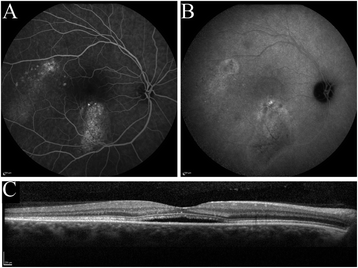Comparing half-dose photodynamic therapy with high-density subthreshold micropulse laser treatment in patients with chronic central serous chorioretinopathy (the PLACE trial): study protocol for a randomized controlled trial
- PMID: 26390920
- PMCID: PMC4578347
- DOI: 10.1186/s13063-015-0939-z
Comparing half-dose photodynamic therapy with high-density subthreshold micropulse laser treatment in patients with chronic central serous chorioretinopathy (the PLACE trial): study protocol for a randomized controlled trial
Abstract
Background: Chronic central serous chorioretinopathy (cCSC) is an eye disease characterized by an accumulation of serous fluid under the retina. It is postulated that this fluid accumulation results from hyperpermeability and swelling of the choroid, the underlying vascular tissue of the eye, causing a dysfunction of the retinal pigment epithelium. This fluid accumulation causes neuroretinal detachment. A prolonged neuroretinal detachment in the macula can lead to permanent vision loss. Therefore, treatment is aimed primarily at achieving resolution of subretinal fluid, preferably within the first 4 months after diagnosis of the disease. A broad spectrum of treatment modalities has been investigated in cCSC, but no consensus exists on the optimal treatment of cCSC. Currently, photodynamic therapy (PDT) and high-density subthreshold micropulse laser treatment (HSML) are among the most frequently cited treatments in obtaining successful neuroretinal reattachment.
Methods/design: This is a randomized, controlled, open-label, multicenter trial comparing the efficacy of half-dose PDT to HSML in treating patients with cCSC. A total of 156 patients will be recruited, 78 patients in each treatment arm, with a maximum follow-up duration of 8 months after the first treatment. A complete ophthalmological examination with vision-related quality of life (NEI VFQ-25) and stress questionnaires, will be performed at baseline, 6 to 8 weeks after the first treatment, 6 to 8 weeks after a second treatment (if necessary), and at the final follow-up visit at 7 to 8 months after the first treatment. Treatment visits will be scheduled within 3 weeks after the baseline visit, and within 3 weeks after the first control visit, if a second treatment is required.
Discussion: Both half-dose PDT and HSML may be effective treatments in cCSC, but because of the lack of prospective randomized controlled trials, which treatment should be the first choice remains unclear. The aim of this study is to compare the efficacy of half-dose PDT to HSML. The primary endpoint to evaluate efficacy will be a complete absence of subretinal fluid on optical coherence tomography after treatment. Secondary functional endpoints include change in Early Treatment Diabetic Retinopathy Study (ETDRS) best-corrected visual acuity, retinal sensitivity on microperimetry, and NEI VFQ-25 questionnaire of visual functioning. Registration number Institutional Review Board (CMO Arnhem-Nijmegen, the Netherlands): 2013/203 NL nr.: 41266.091.13 TRIAL REGISTRATION: ClinicalTrials.gov identifier: NCT01797861 . Date of registration: 21 February 2013.
Figures



References
Publication types
MeSH terms
Substances
Associated data
LinkOut - more resources
Full Text Sources
Other Literature Sources
Medical

